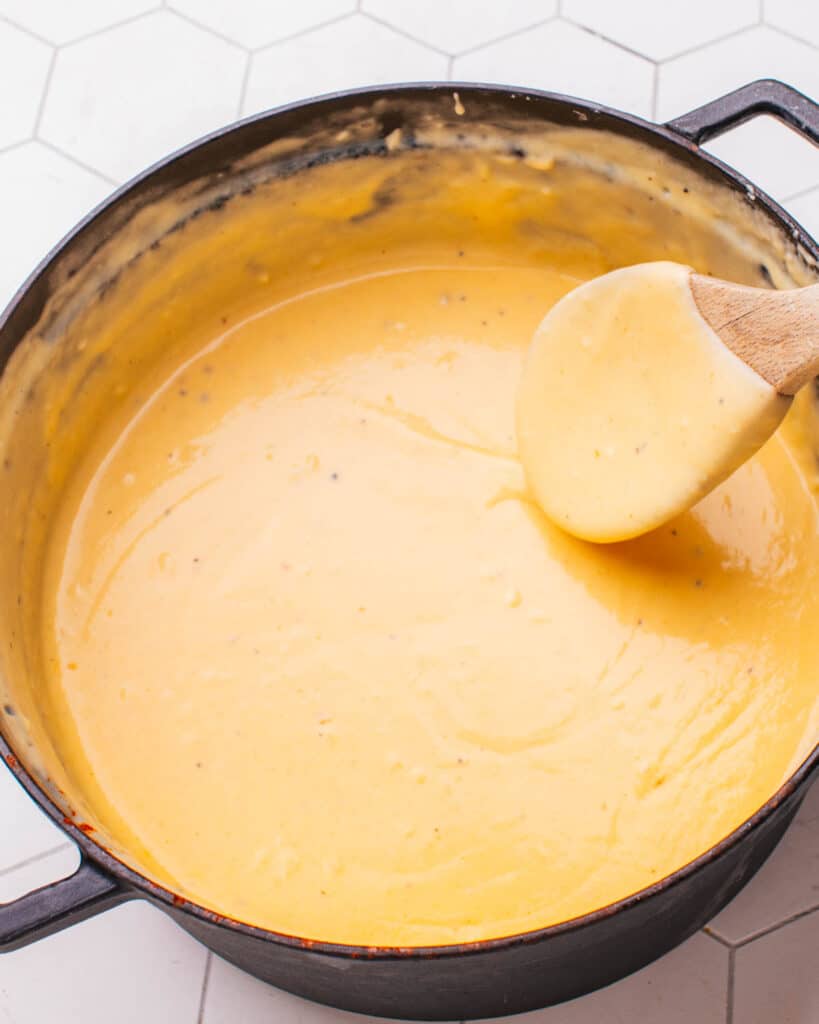6 Best Cheeses For Mac and Cheese (+ What to Avoid!)
Feb 12, 2024, Updated Apr 01, 2024
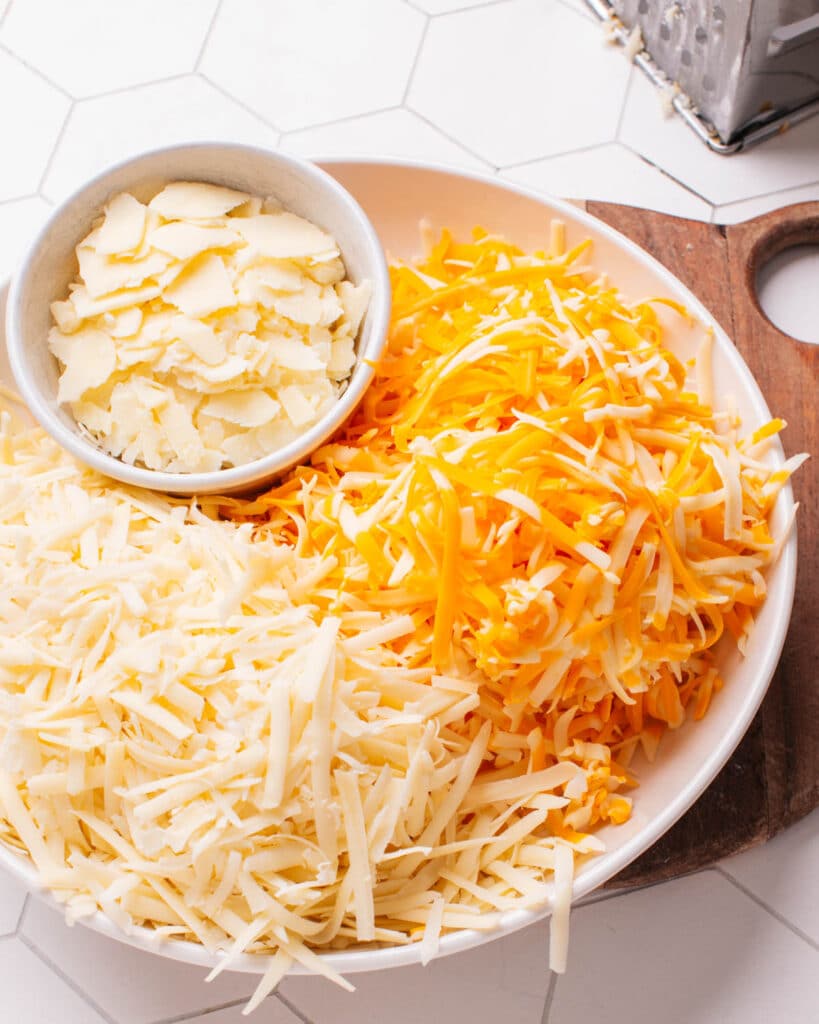
Cheese for Baked Macaroni and Cheese: In a Nutshell
For amazing baked macaroni and cheese that’s both creamy and packed with nutty, cheesy flavor, here’s the short answer. Try any or all of cheeses:
- Sharp Cheddar
- Gruyère
- Monterey Jack
- Parmesan
- Cream cheese
- Gouda
Read on to learn about which is best for melting, what cheese to avoid, and how each option affects the flavor and texture of your mac!
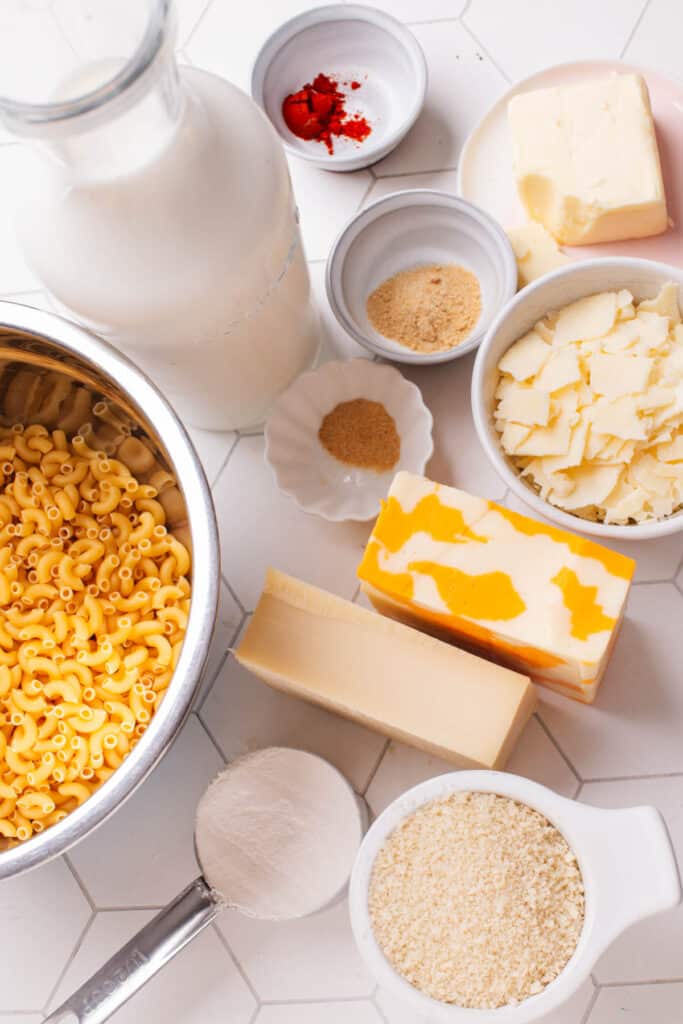
What kind of cheese is best in mac and cheese?
A blend of cheeses is best when choosing the best cheese to use in your mac and cheese.
Here’s a breakdown of the mixture of cheese I use and the features of each cheese.
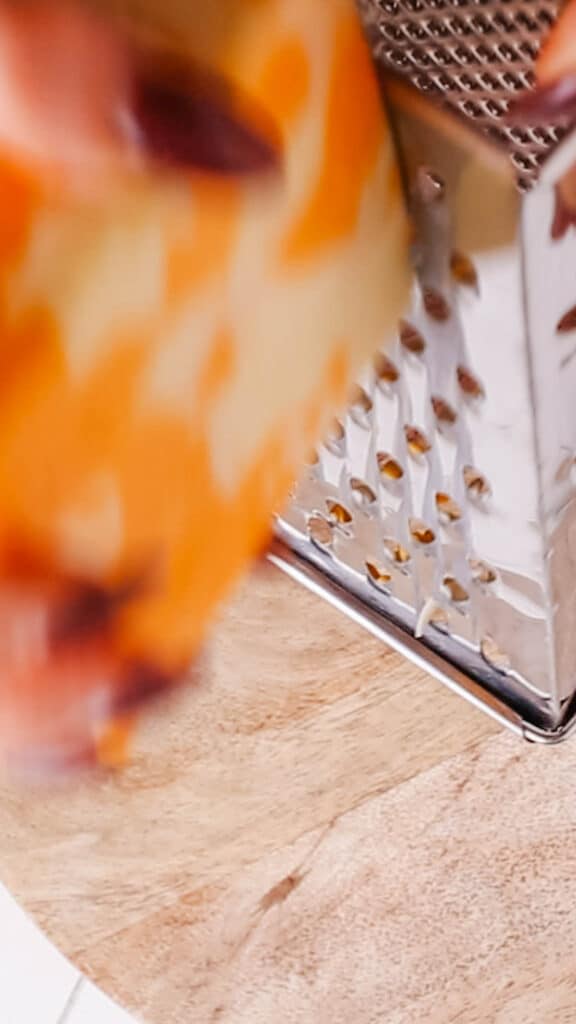
Sharp Cheddar Cheese For Baked Macaroni And Cheese
This is a must. Sharp cheddar gives your baked mac a classic, tangy flavor essential for the perfect mac and cheese taste.
While you can buy pre-shredded cheese, it often contains anti-caking agents that can affect the sauce’s texture. My recommendation is to freshly grate your cheddar cheese.
Just make sure you choose a sharp, not mild, variant.
The intensity gets diluted in the milky sauce and mild cheddar cheeses don’t give that same knockout flavor.
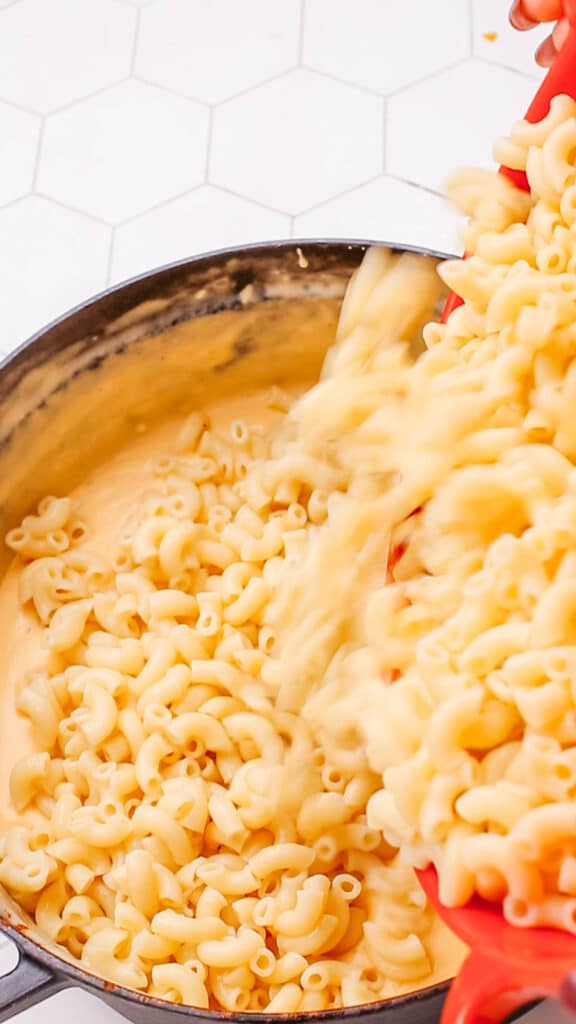
Gruyere or Monterey Jack
These cheeses melt smoothly and add a deeply creamy texture. They also offer your bake a nutty and buttery flavor. Colby Jack is a great alternative to use.
Parmesan
I love it for its saltiness. It’s also the ultimate umami-laden cheese that just lifts all the other flavors in macaroni cheese.
As a topping, it delivers a lovely crust to your yummy casserole dish.

Gouda
Gouda is fantastic in mac and cheese. It adds a rich, creamy texture and a deep, slightly sweet flavor.
Smoked Gouda can bring in an extra layer of taste, offering a smoky twist to the classic dish.
Mixing it with other cheeses, like sharp cheddar, can create a more complex flavor profile.

Cream Cheese For Baked Macaroni And Cheese
Cream cheese is a great addition to mac and cheese. It makes the sauce extra creamy and rich.
Just a bit can transform the texture, making it velvety smooth. Plus, it adds a slight tanginess that can elevate the overall flavor.
I sometimes like to add it with traditional melting cheeses for the best of both worlds. (I also love it in this Cream Cheese Chicken Chili)
Stir 4 oz of cream cheese into your favorite sauce and give it a taste.
What Cheese to Avoid in Mac and Cheese
- Pre-shredded cheese: Often coated with anti-caking agents like cellulose, which can lead to a less smooth melt and a gritty texture.
- Low-fat cheeses: Cheeses that are low in fat have a different protein structure and less fat to act as a buffer during melting. This can cause the proteins to clump together when heated, creating a grainy texture.
- Fresh, high-moisture cheeses: Such as ricotta or cottage cheese, can make your mac and cheese watery and affect the consistency of your sauce.
- Super-strong cheese: like very aged european or blue cheeses; use them sparingly to avoid overpowering your dish.
- Cheese with rinds: Rinds won’t melt. Brie, with its creamy texture and rich flavor, can add a luxurious feel to your sauce. Just remove the rind for smoother melting.
Can I Use Brie or Leftover Cheese Board Cheeses?
Absolutely, you can use Brie and leftover cheese board cheeses in your mac and cheese. I really love it as a delicious way to avoid cheese waste after a party.
Just remember to remove the rind from Brie and other similar cheeses to ensure a smooth texture in the sauce.
Exercise caution with potent cheeses like blue (Roquefort, Gorgonzola etc.) or super funky cheeses (like the more potent European delicacies) to maintain a cozy flavor balance.
I like to keep the majority of the cheese as cheddar to make sure I end up with the comforting flavor I love, and add up to 1/3 of the cheese as eclectic cheeses.
Tips For Working With Cheese For Baked Macaroni and Cheese
Here are my pro tips to use when working with cheese, especially when making a mac and cheese sauce.
While this dish is pretty basic, a few cheese handling tips can help to achieve a smooth, creamy, and flavorful result.
- Grate cheese fresh: Grate or shred the cheese fresh from the block into a bowl before adding it to your sauce. This way you can skip the anti-caking agents that can affect the texture and melting properties of the cheese.
- Heat low and slow: When melting the cheese into the sauce, use low heat or turn the heat off altogether. High heat (and boil) can cause the cheese to become grainy or separate, resulting in a clumpy, gloopy sauce (no thanks!).
- Add cheese gradually: Add the grated cheese to the sauce slowly, allowing each addition to melt completely before adding more to avoid lumps and bumps. Stir the sauce constantly to distribute the heat evenly and prevent the cheese from clumping. I find using a large pot is helpful.
- Use a whisk: This makes it really easy to incorporate the cheese into the sauce smoothly. Whisking helps break down the cheese into smaller particles, promoting even melting and a silky texture.
- Avoid boiling: Specifically once the cheese has been added. Boiling it can cause the cheese to break down and become greasy. Yikes! Keep the sauce at a gentle simmer until it reaches the desired consistency.
- Season thoughtfully: Season the sauce with salt, pepper, and other spices to really bring out the flavor of the cheese. Taste the sauce as you season it – remember that different cheddars, for example, contain different amounts of salt.
- Finish with parmesan: Finish the sauce with a sprinkle of freshly grated Parmesan cheese for added depth of flavor. Parmesan adds a salty and nutty taste that complements the other cheeses in the sauce.
Check out the tips and tricks to making the perfect sauce for mac and cheese here. This post covers all elements of the mac and cheese sauce – including making your roux, seasoning, etc.
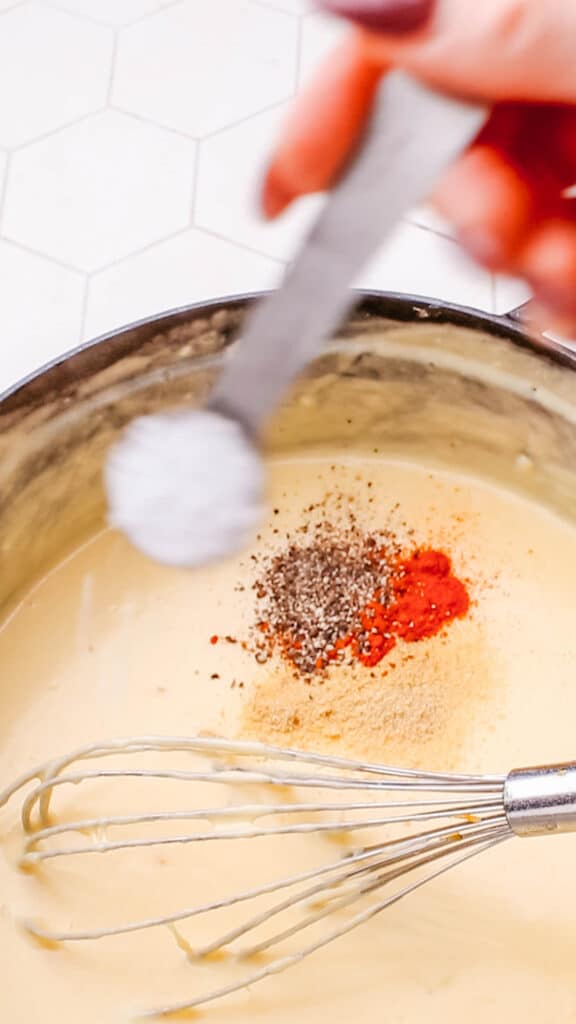
Seasonings to Elevate the Cheese Flavors
Here are the flavorings I like to pair with cheese in my mac + cheese:
- Salt
- Onion powder
- Garlic powder
- Black pepper
- Paprika
Other seasonings to experiment with include – these are sometimes used in mac and cheese recipes:
- Cayenne pepper
- Mustard powder
- Chicken stock powder
- dried herbs
Mac and cheese is one of those recipes that you can customize, so go ahead and experiment with flavors.
Why not stir in some crispy bacon and/or broccoli? Add some cooked chicken to boost the protein and make it a main dish.
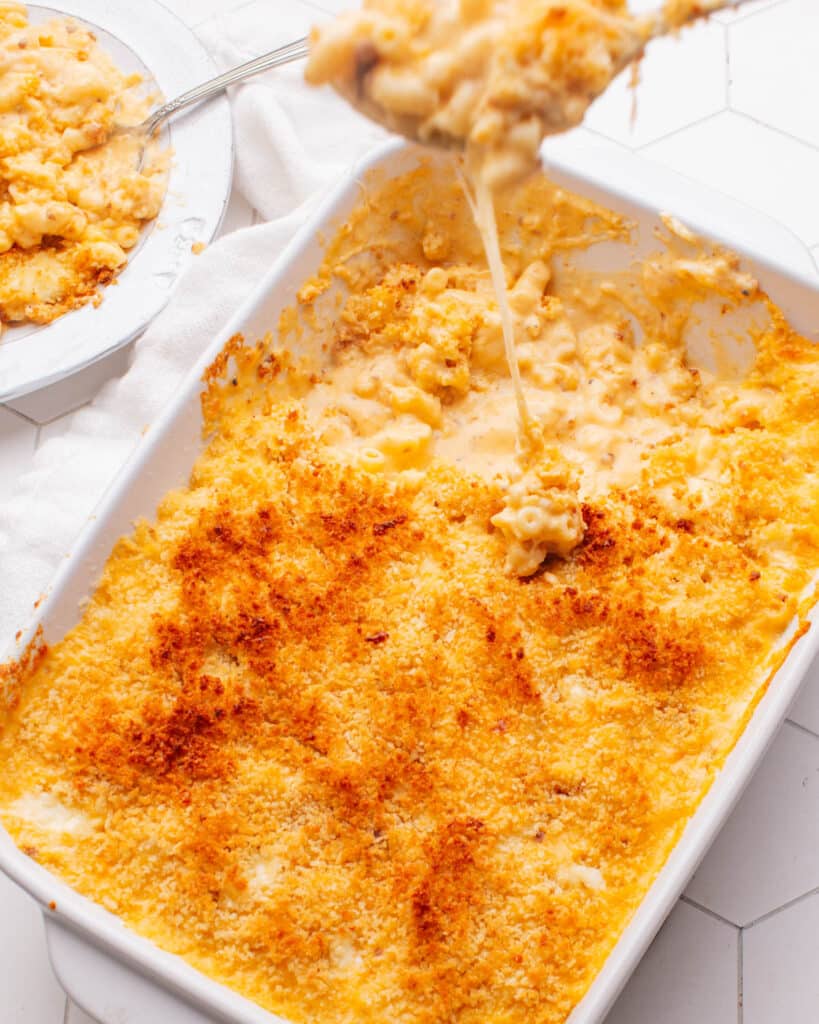
FAQs on Cheese For Baked Macaroni and Cheese
Just skimming through? Here’s a top-line view of everything related to finding/using the best cheese for baked macaroni cheese:
Sharp cheddar, Gruyère, Monterey Jack, and Parmesan are the best cheeses for mac and cheese. These cheeses melt well and contribute to a creamy texture and rich flavor.
To keep mac and cheese creamy when reheating, add a splash of milk or cream to the leftovers before heating them. Stirring the mac and cheese frequently while reheating can also help maintain its creamy texture.
Both mild and sharp cheeses can be used for mac and cheese, but for the best flavor result, sharp cheese, like cheddar, is best. Sharp cheeses like aged cheddar add a stronger flavor, while mild cheeses like Monterey Jack provide a milder taste. My recipe uses a combination of cheese ingredients for balance.
Pre-shredded cheese often contains additives like anti-caking agents, which can prevent it from melting efficiently. Freshly grated cheese melts more smoothly because it lacks these additives and retains its natural moisture content.
Macaroni and cheese, also known as mac and cheese, originated in Italy and became popularized in the United States. Thomas Jefferson is credited with introducing macaroni and cheese to the United States after tasting it in Italy during his travels.
When it comes to melting, not all cheeses are equal. Some melt beautifully, while others don’t. Mozzarella, cheddar, and Swiss are top picks for melting. They’re reliable in recipes where you want a smooth, creamy texture. Mozzarella is great for a nice stretch, like on pizza. Cheddar brings a smooth flow, perfect for sauces and grilled cheese. Swiss cheese, with its lovely melt, is ideal for fondues and sandwiches.
Mac and cheese can become chalky if the cheese sauce is overcooked or if the cheese used is low in moisture. To prevent a chalky texture, avoid overheating the cheese sauce and choose cheeses with higher moisture content for a creamier texture.
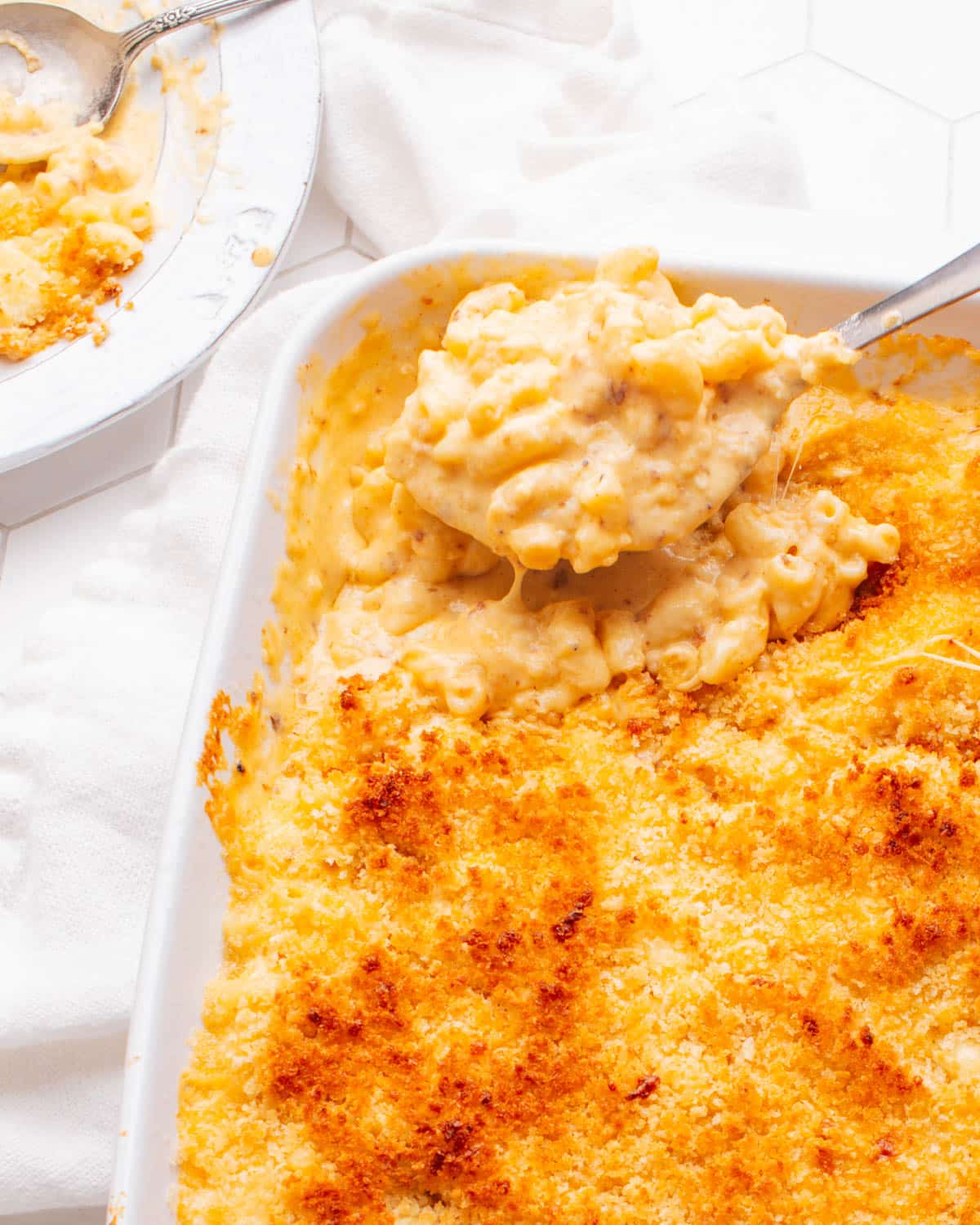
The Ultimate Macaroni and Cheese
Don’t miss my recipe for Old Fashioned Macaroni Cheese here – it’s my tried and tested (and beloved) recipe you need to have in your repertoire.
It’s crusted with panko bread crumbs, melted butter, and dried parsley – you’ve GOT to try it. This is the ideal Christmas or Thanksgiving side dish – al dente macaroni noodles in a velvety cheese sauce.
Did I mention it has a 15-minute prep time? Another must-read for you, if you’re up-skilling your mac and cheese game, is this article about how to make THE BEST cheese sauce for macaroni cheese. It works perfectly in baked or stovetop mac and cheese.
Here, I dive deep on how to make the most delicious, unctuous sauce that is never grainy and always creamy.
Up Next:
- What to Serve with Macaroni and Cheese
- Cheddar Cheese Sauce for Mac and Cheese
- Old-Fashioned Baked Macaroni and Cheese
- Butternut Mac and Cheese
- Miso Carrot Mac and Cheese
Other creamy pasta favorites:

